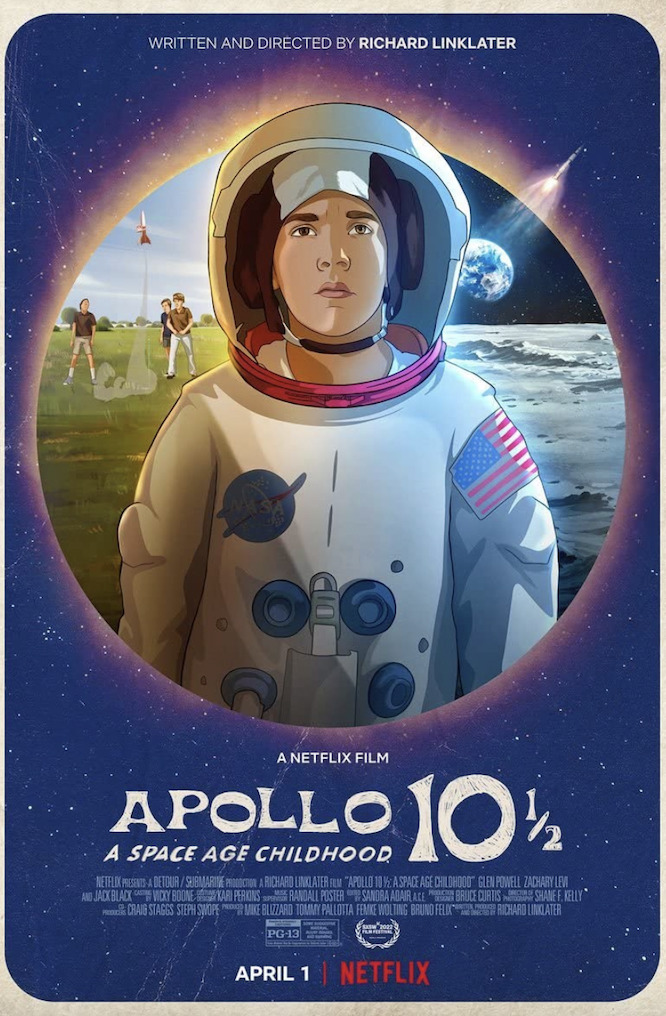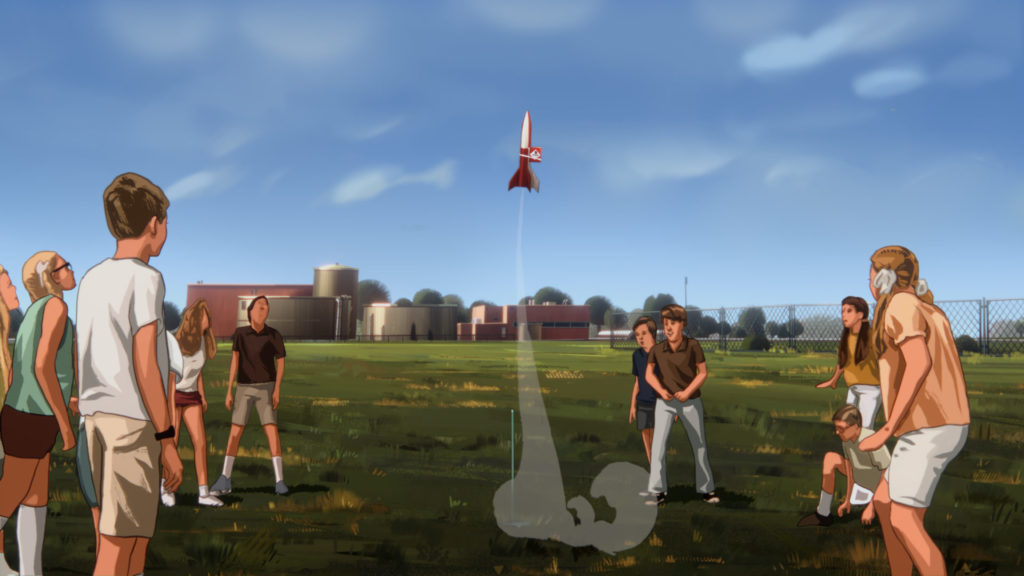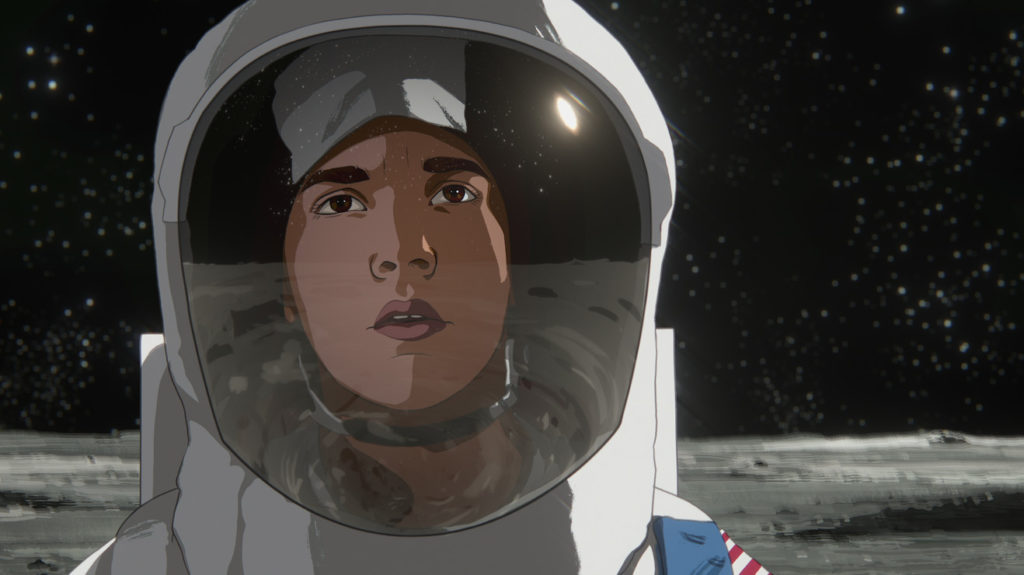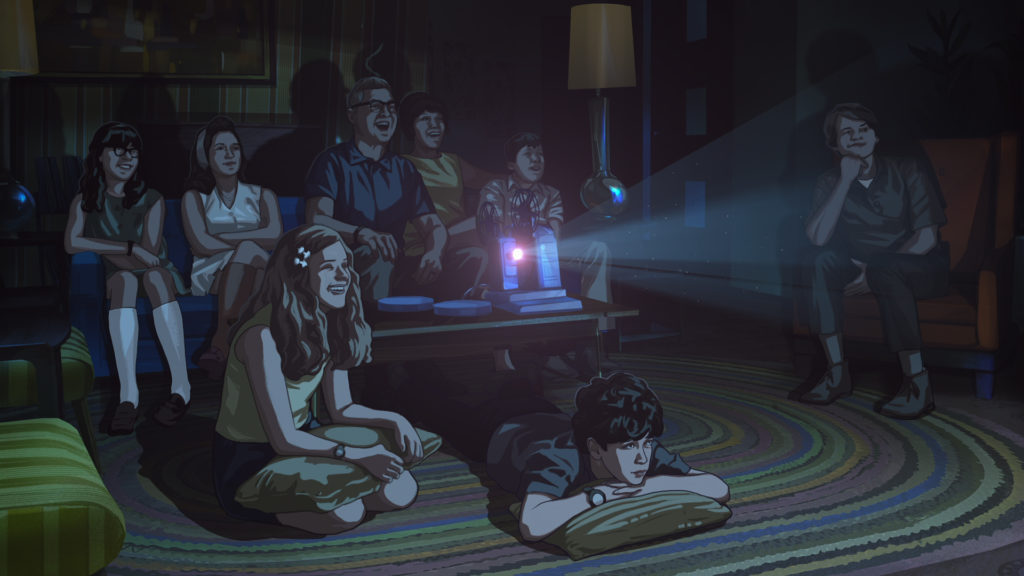
Synopsis : Apollo 10 ½: A Space Age Childhood tells the story of the first moon landing in the summer of 1969 from two interwoven perspectives — the astronaut and mission control view of the triumphant moment, and through the eyes of a kid growing up in Houston, Texas who has intergalactic dreams of his own. Taking inspiration from Academy Award-nominated® filmmaker Richard Linklater’s own life, Apollo 10 ½: A Space Age Childhood is a snapshot of American life in the 1960s that is part coming of age, part societal commentary, and part out-of-this-world adventure.
Q&A with Director Richard Linklater
Q: Though this film is not quite autobiographical, it does have lots of elements of your life. The idea is that you are much more immersed in pop culture. Did you have a film that, when you were just seeing movies for the first time, had a particular impact over everything else?
RL: When you’re little, every movie you see is the best movie you’ve ever seen. I remember it was a wide variety, but I didn’t start taking film seriously until about age 20 or sometime in college. If you’ve seen “The Fabelmans,” there’s the kid who sees a movie, gets a camera and films train sets. I had a Super-8 camera, was editing and doing stuff, but I didn’t think of myself as a potential filmmaker. It wasn’t on my purview.
So it’s fun to make films about kids because I wanted this film to be both [autobiographical] and also [about] this pop culture history. I came into this with a kid’s fantasy element that was a real fantasy of mine. I thought that by having the adult perspective of an older narrator I could put in a cultural critique [as well]. A counter-history [could be in here] too. I was inspired by Philip Roth’s “The Plot Against America” — something like that. If you can ground it in specifics, autobiographical specifics, maybe the audience will buy into your fantastical parallel story.
Q: It’s a magic trick, kind of an intimate epic. It feels very specific and also covers so much ground so they’re overwhelming.
RL: It is funny how we were all sharing the same childhood because the culture was pretty….
Q: When you share this with your own children or with people their age, how do they react?
RL: I’ve really liked the response of young people. I don’t know if I intentionally set out to do this. I don’t want to ever say, “Oh, that was a better time to be alive” but they do notice the freedom that young people have that’s been absent for a generation or two. You don’t have your parents, you’re not accounted for every second of the day that you could just run around in the neighborhood. They also think it’s pretty funny, the level of disregard, maybe, and danger, abuse you could call it, that was just regular at that time — the paddlings and all that. I think it’s a mixed bag, but I was just trying to be honest. I could look back on that ironically. We all survived, but when I run into people our age, it’s kind of like, “Yeah, we could just leave and come home for dinner.” It’s a depiction of a different time and place.
Q: One thing that tempers this is just how beautiful the film is, how vivid the colors are in the sense of the time being both abstracted and smoothed out. There’s a kind of innocence and sweetness that’s really touching. There are these undercurrents maybe every 10 minutes or so, that there’s something awful is mentioned but that slides through. That was a curious balancing act. How conscious of that were you?
RL: I really was thinking back on that time and it was the wonders of just being a kid or looking to the future, which is a kind of Kodachrome, Technicolor. It’s a nice palette that we could explore and these dark undercurrents of the time. It was just this existential fear of being annihilated by a hydrogen bomb or the ever-present war. Really, the ’60s compared to today, people think it’s bad. It was kind of insane. What was coming out of the TV was crazy. We had protests and stuff, but you just don’t have cities on fire for weeks. It was just crazy. There was the body count from a war that was unpopular and people in the neighborhood going off to war — dads and brothers. It was intense, and you woke up and it was hard to process as a little kid. Your older sister opened the door and was like, “Oh, Kennedy got shot last night.” You’re like, “Didn’t he get shot a long time ago?” “No, the other Kennedy, Robert.” It was like, “Oh shit, now Martin Luther King.” It’s like there’s always an assassination. There’s always a war. Yeah, it was crazy. And yet, it was such a great time to be alive. So much optimism in the air. We were going to the moon. So I tried to capture that.
Q: Feels like you’ve got a lot of colors of ice cream, a lot of flavors of ice cream into the film.
RL: That was actually my uncle who always got the free ice cream. And my sister did work there.
Q: The actress playing your sister is really amazing. How did you find her and what else has she done?
RL: Natalie. She’s a wonderful actor. She’d been in a few movies and just lives in Austin, Texas. Came in and yeah, it was kind of great. I didn’t have, because it’s animated, I think it wasn’t really pressure to have, I could just cast people I thought-
Q: That makes it so fresh and vivid. Maybe you can help out everyone here who is equally ignorant. You shoot a movie with real people and then throw it into this process that adds layers and imaginary things. Can you describe how you factor it in?
RL: We just call it performance capture and it’s really very different. I’ve made two animated films before, Waking Life and A Scanner Darkly, and this was a whole different process. Tommy Pallotta, my partner in this, we’ve been developing a new [concept]. It’s different from the rotoscoping we had done before. There’ve been a lot of advancements in the technique. We got money about 10 years ago. I was developing something that never happened, but he has this Amsterdam company and there were actual paintings, Dutch and their paintings, they could whip up these paintings and we were dropping in performance captured people using the kind of rotoscoping technique, but not the kind we used back then. It’s all new to us. So we just called it two and a half D. It’s really a two B movie.

Q: Hold on. You have a shooting schedule with the actors.
RL: You shoot the movie, it’s scripted. We rehearsed casts, but the difference is we were shooting, for guys like us who do, locations you use. It’s very different. It was all shot in a green screen environment. Every shot in the movie is a special effect.
Q: You’d have real ice cream and the countertop brought in. Or even that one.
RL: If an actor is interacting with something, a prop or anything that would cue the animators to something. But other than that, the living room, there were no things, there were no walls. It was kind of like make-believe. Like okay, you’re walking through the drive-in movie theater and the screens over there, you’d give Xs and get eye lines right, and then it would all be planned. We shot this pretty quick. We got greenlit and were shooting in about six weeks. I told production designer Bruce Curtis, “Good news or bad news? Bad news is we have six weeks till we start. Good news, we don’t have to build anything. We just have to design it and get all the dimensions right.” We could look and tape off the floor and then just build. For instance, when he’s in the lunar module, there’ll be one switch that’s real because he interacts with it. It’s just a green panel with one switch and maybe drawings of others. And that’s the only operable one.
Q: How many weeks were you shooting then?
RL: It was like a 20-day shoot.
Q: That’s brisk.
RL: it’s all performance which I take seriously. As many takes as we need, and we can get those performances. But it was really fun. It was like filming a rehearsal, a lot of make-believe, but it’s not that different from a lot of Marvel films. Okay, here’s what’s going on, you have to make-believe. And we didn’t really know how we were still designing a lot of it, a lot of that we didn’t exactly know how we were going to do it. We just knew we were going to figure it out. So it was kind of seat of the pants, very hand-drawn, very creative, fun. It’s so funny that the multi-year process and let’s say two year process that the shoot was only 20 of those days, but you work every day.
Q: And how much did COVID factor in?
RL: Yeah, we did all the anime, we wrapped, and good thing we shot quickly because we wrapped… Like at our wrap party, COVID was knocking on our door. South By in Austin was canceled. There weren’t any cases yet, but it was coming. So we made it out. The whole industry shut down within a week of us wrapping and we didn’t really lose much animation. It was a great, fun project to be working on during such a horrible time in our world to be working on this thing set in the past.
Q: Was Tommy working long distance? Where was this-
RL: I swear I don’t feel like we lost any time. You can just share a screen and talk, and it’s like you’re looking over and you’re in the editing room together. I think in generations past it would’ve been such a disaster, but animation did affect it because they tend to work in groups and stuff, so that was quite an adjustment. Everybody adjusted and just tried to make it work, but in animation it was fun, I was really proud of the effort. Everybody brought their creativity to it.
Q: There’s a way that most of your films have an element of time, that they acknowledge that people move through time that shapes us and confuses us. You do something deft and even a little confusing with the way that he slides in and out of fantasy, memory, recollection, that there was like dreams within dreams in this movie. How much of that did you consider going in, and how much did you discover?
RL: It was all there in the script, it had to be for the transitions. That evolved over time, I thought about that, I had the idea for this in like 2004, so I had years…
Q: You didn’t think of it as an animation initially?
RL: Not initially, but I was really just obsessed with the story and the characters, and trying to find what would work. That put me on this path of doing a lot of research, so I got to re-experience that era. Like for instance, getting ahold of the archives, all the CBS news, I was just amazed from my adult perspective what an impressive TV production it was. That’s why I leave that in at the end where Cronkite says, “And it came along at the time of television,” it was a television production. You could look at it cynically like the whole space race, the whole Apollo program, landing people on the moon was a Cold War exercise funded by the US government and promoted by our culture to the world, triumphant. As a seven, eight-year-old, it hadn’t registered that there were people that weren’t down with it, because I was so excited about it. Everybody I knew was, but hippies weren’t. It looked militaristic, another aggressive American thing in the world, planting the flag and all that. I think that the dissident element, the people who weren’t down with it, faded from view a little bit, but I wanted to bring that back up.

Q: You smuggle it in. Who was the woman whose hair Vicky admires, who was that?
RL: Gloria Steinem. To the TV’s credit, it was such a production, they had so many great science fiction writers, astronauts, the people coming through the production were amazing. Then they invited Kurt Vonnegut, who was just crapping all over the program, Gloria Swanson, all the political people of the day, it’s pretty funny. The discussion was on the table, I really admired it, and I think Cronkite and Eric Sevareid, you can feel them reaching for the moment the way astronauts do. They’re trying to find poetry, they’re trying to find meaning, and I think they do in a beautiful way. Sevareid especially, he was really just trying to stick the landing for the importance of what was happening.
I don’t know if anyone really could, but they sure tried and I was so impressed with that, so impressed with that whole production. From an adult standpoint, I was even more impressed than I even remembered. You didn’t know it at the time ’cause you thought it would be superseded by more spectacular things, we were going to be onto Mars and we were all going to be on the moon by now, all that. Like that great team that was great, but you look for all the next Super Bowls or World Series and they never happen, so that team becomes the best ever, that’s kind of what happened to the Apollo programs. It’s like, “Oh, Saturn is the best rocket ever,” it didn’t progress for various reasons so it’s still this benchmark of achievement that hasn’t been topped. It’s the world’s greatest engineering feat, let’s say.
Q: there’s the catchphrase, “Nostalgia isn’t what it used to be.” nostalgia isn’t necessarily a negative thing. It has a shifting value in your awareness of your own footprints in the sand change, as you start to realize how the sand is changing, how the cultural landscape is changing. one element in this film that’s really amazing is how it tries to take stock of these layers of memory, and retrieve things that are every day and cute even, and sweet. That isn’t so easy to deal with or to come to terms with, that’s part of the mystery of history.
RL: Isn’t that what’s going on in all of our minds as you think of your own past or cultural past?
Q: You don’t usually find it in movies, so you really have achieved something.
RL: I’m always trying to capture how my mind works or how we process the world, and I’m always amazed that looking at the past, it’s always bittersweet. I’m not really nostalgic, I wouldn’t want to go back, I don’t think it was a better time, it was not. There is no better time to be alive, I firmly believe that, just ask almost everybody, it’s not even close.
Q: There’s real power in remembering it and improving it.
RL: You have your points along the way that have meaning to you and others. I don’t know, you have to make choices representing it, that’s the choice. How far do you go in each direction? I’m not that sentimental, that’s why it’s layered in with everything else. I could go really dark, there were serial killers operating in Houston at this time; there was horrible stuff going on everywhere, but that didn’t find a place in my narrative.
Q: What did your family, both your own siblings or whatever and your kids think about this film, and what did they learn about you? What did you learn about you in terms of looking back and thinking about that era? What did you find out about yourself when you went back and looked at it and filtered through all your collections and other things, and the family’s reaction?
RL: The family’s reaction was just fun. Actually, I had warned them, and my sisters were advisors. If I have one gift, it’s a good memory, but certain elements like the family menu, because they were closer to that, I was the guy taking out the trash and washing dishes, they were more helping my mom so they could, “Oh, don’t forget the canned ham.” I’m like, “Oh yeah,” so they were helping on that, but they were amused. I warned my dad, who just turned 92, I said, “Okay, there’s a dad in this, you were never that tight. I’m making fun, I mean you were frugal but you weren’t crazy.” I’m having fun with that, I warned him in advance, but my dad, they don’t take it seriously ’cause he didn’t work at NASA, for instance, so I made that conceit. I didn’t go to the elementary school right next to NASA, I went a couple away, it was just whatever tells a better story. I actually only lived near there for about a year and a half, I’m not a suburban kid, I grew up in inner city Houston and then we moved to a small town. I was really only out in those suburbs for a brief amount of time, but they left an impression ’cause they were so different than the school and the city I knew. It was like, “Wow,” it was all flat and clean and so white, and it was a different world.
Q: What were some of the biggest challenges that you had on set regarding the performances.
RL: A lot of it is just directing, you’re just communicating, trying to teach all these kids how to ride a bike. It’s amazing what they couldn’t do.
Q: Like Dodgeball.
RL: Yeah, all the fun stuff, but they had a blast, and the two older siblings, they were actors, the four younger ones had not been in movies, so it was just trying to get them into the spirit. They were great, a real team, and I do okay with non-actors, especially the main kid, Stan. That was a tough part, but I really don’t like too much of the cute kid acting. He was so confident in himself, even with the callback, as kids started disappearing and it became less and less kids, I could see other kids getting nervous and he was just like, “Meh.” I wanted that quality, like, “We need you to go to the moon,” he was like, “Eh, okay,” I wanted that to be the attitude, not like a cute, parent-pleasing kid. He was the opposite of that, so he had this confidence, but he’s not really an actor so you’re kind of manipulating, just making it comfortable. There’s not much you can do once you’re in editing, that’s why I put a lot of stock in the shooting, like that’s the movie to me. You have that performance, but besides editing the movie you’ve got to live with what you shoot on that day, so it means everything.
Q: Nostalgia usually runs in roughly 25, 30-year cycles, so the ’90s, tons of movies about the ’60s, some about the early ’70s. People these days,there’s a lot of nostalgia now for the ’90s and Jerry Seinfeld and all these things, so we’re now plus-50 years post-Apollo landing, so why this story now in 2022?
RL: Believe me, I don’t sit and think, “The nostalgia cycle is coming around. I’m most nostalgic for eras I never lived in, other centuries, other places in history that I find really fascinating. I remember as I came of age in the ’70s, there was a lot of this interest in the ’50s, maybe because of the movie American Graffiti and Happy Days, and we’d have sock hops at school and things like that. I remember my uncle pulling me aside and saying, “You guys think the ’50s was something, believe me, the ’50s sucked, okay?” I always had this kind of jaded view, and when I made my ’70s film in the early ’90s, I actually thought, “I’m going to make a film showing how crappy it was.” I didn’t intend to make a nostalgic film, but I think that my movie “Dazed and Confused” is seen that way. The lesson there is that Film is nostalgic. Roger Ebert called it an empathy generator, which it is. It’s also a nostalgia generator. It can be dangerous, nostalgia for wars. Anti-war movies become pro-war movies really easily, because of this little pre-condition we’re fatally drawn to about some better time in the past, or, “That was so clean, easy morals,” or whatever. It’s all fake; it’s all not true. Nostalgia can be a really double-edged sword. it can be really dangerous I think.
Q: What’s next for you? I know you just finished shooting.
RL: Yeah, I’m doing sometime I think later in the year, a film set in New Orleans, a dark comedy crime thing loosely based on a true story. “Hitman” is a pretty funny, dark comedy about murder that stars Glen Powell as Gary Johnson. And I’m doing a film based on Stephen Sondheim’s “Merrily We Roll” which takes place over a 20 year period. I will have a cast that will grow along with it. [Ben Platt and Beanie Feldstein were picked for it back in the summer of 2019 when the project first began filming. Recently, Paul Mescal was cast to replace Blake Jenner.]

Check out more of Nobuhiro’s articles.
Here’s the trailer of the film.

